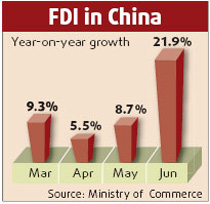Led by think tank China Development Research Foundation, a group of economists are pushing the country's leadership to accept their proposal to redefine poverty in China.
In a report on poverty released yesterday, about 30 economists led by Wang Xiaolu suggested the government raise its poverty line and include basic expenditure on education and medical services in the calculation.
Preliminary estimates have found China's poverty line - including annual average expenditure on education and health - should be around 1,100 yuan instead of the current 683 yuan. The current amount is the yearly sum needed to buy minimal food and clothing for survival.
"Using the standards we propose, 80 million Chinese are still in poverty, rather than the official figure of 23 million (using the official standard)," said Wang, a senior research fellow of China Reform Foundation and leading author of the report, Alleviating Poverty through Development.
Different countries have different formulas for setting the poverty line. Some use the relative poverty standard, for example, which defines 20 percent with the lowest income in society as poor, regardless of economic and price conditions. The World Bank defines those who live on less than US$1 a day as poor.
Some experts said Wang's proposal to include basic expenditure on education and health is encouraging but even his poverty line is low.
"Under the current inflation level, the new poverty line can't cover basic needs, including education and medical services," said an economist surnamed Lin with the Chinese Academy of Social Sciences.
China's consumer prices have been rising for five straight months, with the inflation rate reaching an 11-year high of 6.5 percent in August, making it impossible for many poor people to buy even meat.
With the economy growing at an annual pace of 9.7 percent in the past 29 years, Wang said the country has gathered the capacity to redefine poverty and invest in the poor.
"Our second suggestion is to treat the poor as potential human capital, instead of just needy people," Wang said. "This mindset change is vital."
The economists urged the government to take "social inclusion" actions to ensure that the poor can access education and medical services to enable them to live a decent life.
The economists warned that if the basic needs of vulnerable groups are not satisfied, China's growing disparity gap will be further widened and the poor will be even more marginalized, posing a threat to the leadership's goal of social harmony.
Treating the root
Lu Mai, secretary-general of the China Development Research Foundation, said all suggestions were based on an analysis of the causes of poverty and China's current development status.
Organized by Lu's foundation, the survey done in 2006 among 4,041 poverty-stricken households in 72 villages nationwide found that poor income in the agricultural sector and growing expenditure on healthcare and children's education are the three top causes of poverty.
About 72 percent of the respondents listed low returns from crops as the major reason for their poverty.
China's 23 million poor people, decreasing from 218 million in 1980, mainly live in mountainous regions and along the borders. These regions are not as well connected and have limited resources to develop the local economy.
Nearly half of the poor households said expenditure on medical services had made it difficult to make ends meet.
China has already brought 70 percent of its farmers under a cooperative medical insurance network, according to the Ministry of Labor and Social Security. However, farmers on an average still have to shoulder at least half of their medical costs.
About 36 percent of the households cited the high cost of children's education as the reason for their poverty.
Wang Sangui, a co-author of the report and professor of Renmin University of China, said the pace at which China has been lifting its poorest citizens out of poverty has slowed in recent years and the major reason for that is the lack of human development capacity among the poor. This, in turn, is caused by financial difficulties in taking care of healthcare and education.
The economists said they expect the country's leadership to adopt more concrete measures and ensure their implementation to curb destabilizing factors such as the growing income gap, which can endanger social stability and public security.
China's Gini coefficient, an internationally accepted measure of income equality, was estimated by some research organizations at 0.47 this year. The "alarm boundary" is 0.4. The coefficient was 0.3 in 1982 and 0.45 in 2002.
The report said it is high time the government targeted balanced social development as a major policy goal as China is trying to quadruple its economy by 2020.
"Inequity is evident and concrete help should be immediately extended to those in the lower levels of the social ladder," said Chen Xiwen, renowned development researcher and director of Central Leading Group of Agricultural and Rural Work.
To achieve equality for the poor, the government will need to redouble its efforts to set up a social security network and increase educational and medical subsidies, Chen said.
Without good education, the poor won't find decent jobs and their vulnerable social status will be perpetuated over generations.
(China Daily September 26, 2007)


